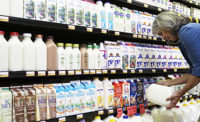The opening of new U.S. stores by Lidl, Arlington, Va., was less disruptive to competing supermarkets than some grocers had originally feared, according to a study released by Catalina, St. Petersburg, Fla.
Catalina shopper intelligence shows that nearby incumbent supermarkets lost close to 7% of overall sales during the first month of a Lidl store opening, but the impact on those same stores declined rapidly, falling to less than 2% of store sales by the fourth month.
The report, “Defending Supermarket Share When Lidl Comes to Town,” is said to represent the most in-depth, purchase-based research to date on the effect of U.S. Lidl store openings on competing supermarkets. The study examined shopper behavior at 83 incumbent supermarkets within three miles of 30 Lidl stores that opened in 2017. The study tracked shopper behavior across different grocery departments and demographic groups during the first 16 weeks of a Lidl store opening.
The study also shows that name brand products provided a significant competitive advantage for incumbent grocers vs. Lidl’s heavy emphasis on private label. The percentage of sales declines among name brands was approximately 3.4 times less than for competing grocers’ private label products. Three departments—produce, beer and wine—accounted for the majority of the total sales decline. Meanwhile, center store aisles were far less impacted.
Demographically, Hispanic and African American shoppers and larger households were more likely than the average shopper to shift spending to Lidl. The study found no meaningful variance among income groups.
“This study demonstrates the importance of shopper analytics in helping retailers keep pace with new competitive threats and changing shopper behavior,” says Tom Corley, chief global retail officer and president of U.S. retail. “Retailers need to pay close attention to how new competitors are impacting their shoppers, and respond with the right pricing and promotions strategies to protect and grow share. It is also clear that well-recognized brands can provide a strong competitive advantage against new retail models, including Lidl, that emphasize private labels over name brands. Retailers should work with their manufacturing partners to fully leverage that advantage.”
Among detailed findings of the study:
· During the 16-week study period, incumbent stores lost a total of 4.3% of sales. Trips declined 3.6%, and shoppers declined 5%.
· Sales declined by 6.8% in the first month, but were down only 1.9% by month four.
· Three departments—produce, beer and wine—accounted for 60% of the total sales decline, even though those departments account for just 16% of overall store sales.
· The center store, comprising shelf stables and general merchandise, accounted for just 7% of total losses, although they are approximately 40% of overall store sales.
· Private label products represented 58% of lost sales, although they account for only 28% of store sales. Name brands represented just 42% of the sales loss, although they account for 71% of store sales.
Demographic insights
Hispanic shoppers were far more impacted than the average shopper, reducing their purchases by 9.2% vs. the 4.3% average. African-American shoppers reduced sales by 5.4%, while sales to Caucasians were down just 3.7% and Asian Americans just 3.3%.
Larger households with five or more people declined at 127% of the average. Younger shoppers were slightly more likely to reduce purchasing, while shoppers 65 years and older were impacted 25% less than the average.




